(1931 – 2008)
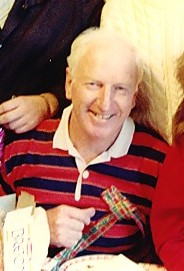
The purpose of this blog is to pay tribute to an old friend and colleague, Bruce Huggett. Among his many personable qualities, Bruce was well known for his dependability, loyalty and integrity.
I believe I met Bruce for the first time when I joined the National Crime Authority (NCA) in June 1985.
In January that year, when he was a Detective Inspector with the NSW Police, Bruce was appointed by the Chairman of the National Crime Authority, Justice Don Stewart, to be the Chief Investigator of the Sydney Office of the NCA. Bruce accepted the offer and was appointed at the rank of Detective Chief Superintendent.
Prior to this, in 1981 Justice Stewart had been appointed to head the Royal Commission into Drug Trafficking, which involved investigating the activities of the “Mr Asia” drug syndicate. Stewart needed a chief investigator he could trust. The candidate needed to be beyond reproach with no doubts about his competence and integrity. It did not take Stewart long to recruit Bruce Huggett, then a Detective Inspector with the NSW Police. After the Royal Commission completed its work in 1983, Stewart was again appointed to chair anther Royal Commission, this time to investigate the collapsed Nugan Hand Banking Group. Without hesitation, Stewart requested Bruce to remain on as the Commission’s chief investigator.
In 1984 when that second Royal Commission closed, Stewart was appointed as the Chairman of the newly formed NCA. Stewart was so impressed with the work that Bruce had undertaken at the two Royal Commissions, in January 1985 Stewart took steps to ensure that Bruce was appointed as the chief investigator at the NCA. In that role Bruce played a significant role in developing the successful investigative strategies and methodologies adopted by the Authority.
In my role as a team leader at the NCA, I had a lot to do with Bruce. This mainly occurred when I was required to report to the Chairman about the progress of the investigation I was leading, which was known as “the Silo Reference”. It involved the criminal activities of two notorious Australian drug traffickers, Bruce “Snapper” Cornwell and his side kick, Barry Bull. Both of those criminals had been untouchable until then, mainly, as we found out later, due to their dealings with corrupt police. Cornwell obtained the nickname “Snapper” because he was a slippery fish to catch.
The Silo investigation was very successful and after we had uncovered their criminal activities involving drug importations into Australia, in late 1985 Cornwell fled to England and Bull to Austria. We quickly tracked them to those countries and took steps to have Cornwell arrested in London and Bull in Innsbruck. Both were subsequently extradited to Sydney.
Prior to Bull’s extradition, in June 1986 however, he escaped from Police custody in Innsbruck, Austria. Shortly after that, thanks to the NCA’s intervention, he was re-arrested a month later in Graz, Austria. Given the drama associated with his extradition, Don Stewart, the NCA Chairman, insisted that I travel to Austria to assist and facilitate the legal proceedings to bring Bull back to Australia. That involved me spending several weeks to observe and assist the proceedings in Austria. Towards the latter part of my time in Vienna, I was joined by Bruce, who had the task of organising the physical transfer of Bull back to Australia. Both Bruce and I were part of the police escort bringing Bull back to Sydney in October 1986.
I remember very fondly the ‘down time’ time Bruce and I spent together in Austria, waiting for the actual extradition of Bull to Sydney to take place. Our time together involved some weekend tours, which included a memorable day train trip to Saltsburg. I believe I infuriated Bruce with my photography. His view was I spent time taking too many photos of architecturally significant buildings and tourist landmarks, rather than of people. I suspect he was right and some years later, he said that I must have taken a photo of every church in Europe. When I defended my photography, Bruce said I accused him of being a ‘philistine’, although I have no recollection of saying this.
During 1986 a very significant event occurred, which would change both Bruce’s life and mine life forever.
This occurred in February that year when Bob Greenwood was appointed as an Acting Member of the NCA. One of Bob’s duties was to oversee the “Silo Reference”. In that role I worked very closely with Bob and he in turn worked very closely with Bruce.
Bob Greenwood was appointed to the NCA on a twelve month contract only, at the end of which he left the Authority. Shortly after his departure, Bob was appointed by the Hawke Federal Government on 1 April 1987 to head the newly formed Special Investigations Unit (SIU), to investigate allegations that Nazi war criminals and collaborators had migrated to and were then living in Australia.
Bob wasted no time in recruiting staff for the SIU. He very quickly brought Bruce on board as the SIU’s Deputy Director (Investigations). At the time, Bruce, who had been recalled to the NSW Police Service, was serving as the Officer in Charge of the NSW Police Internal Affairs Branch. To achieve the desired outcome, Bob Greenwood took steps to ensure Bruce would be seconded to the SIU. This occurred when the Federal Attorney-General’s (Lionel Bowen) made a ‘request’ to the NSW Police Commissioner. In the role of the SIU’s chief investigator, Bruce again demonstrated his unique qualities and abilities by setting up the outstanding and historic investigative capacity of the Unit. He played a major role in recruiting the SIU’s investigative and forensic staff.
At the same time, Bob Greenwood also approached me to join him as his Deputy (Legal) at the SIU, an offer I initially declined, but later accepted in September 1988. I will return to our work at the SIU a little later, but let me provide some details about Bruce’s earlier life.
He was born in November 1931 in the NSW country town of Dripstone, near Wellington. He grew up and went to school in Dripstone and the nearby town of Bakers Swamp. He left school to help his father with his milk delivery run and later turned his hand to rabbiting, before working for a time in the mines in Cobar.
Bruce had very fair skin and his exposure to the sun over the years required constant treatment to remove sun spots and skin cancers.
He joined the NSW Police in January 1952 at the age of 21, and spent his early years serving in country NSW. In 1975 he was transferred to Sydney where, as a Divisional Detective Sergeant, he led teams of detectives in various city districts. Bruce acquired a reputation of being a reliable, competent and honest police officer whose integrity was never in question.
Returning to Bruce’s work at the SIU, he wasted no time in getting the ship underway. One of his early tasks was to gather as much information, intelligence and material which was readily available. This included obtaining all relevant potential evidence gathered by the ABC’s investigative journalist, Mark Aarons, who had spent almost a decade gathering evidence that there were indeed Nazi war criminals living in Australia.
Mark has recorded the following comments in this regard:
“…one morning in early April, I found an intriguing message on my desk. ‘Please ring Bob Greenwood of the Special Investigations Unit.’ I knew that Bob had been appointed to head the SIU by Commonwealth Attorney General, Lionel Bowen, and had taken up his duties on 1 April. I had wondered if he would want to see me to discuss some form of cooperation, as I had collected a vast amount of material that he might find useful.
…After my initial meeting with Bob Greenwood, I was harassed for weeks by one of the SIU’s early staff members. Bruce Huggett was both a gentle man and an old-fashioned gentleman. He, however, hounded me mercilessly to complete the task he had allotted me: correcting the SIU’s rudimentary transcripts of these interviews (I had collected during my recent trip to the Soviet Union). No sooner would I finish one and sigh with relief than Bruce would be on the phone nagging me to get the next one finished. Although I had much to do in my ABC job, eventually I decided it was easier to accede to his constant demands and finish the job.
Bruce died far too young, and I miss him still.”
At the SIU, Bruce and I worked very closely with the other investigators at the Unit and on several occasions we were on mission together in Europe.
The very first of these missions took place in September 1988, less than two weeks after I commenced duty at the SIU. I was asked to join Bob Greenwood and Bruce on a pre-planned trip to Italy, Israel, Germany, France, the UK and the USA.

Bruce sitting opposite Bob Greenwood in the ‘Long Bar’ at the Raffles Hotel in Singapore, on our way to Italy.
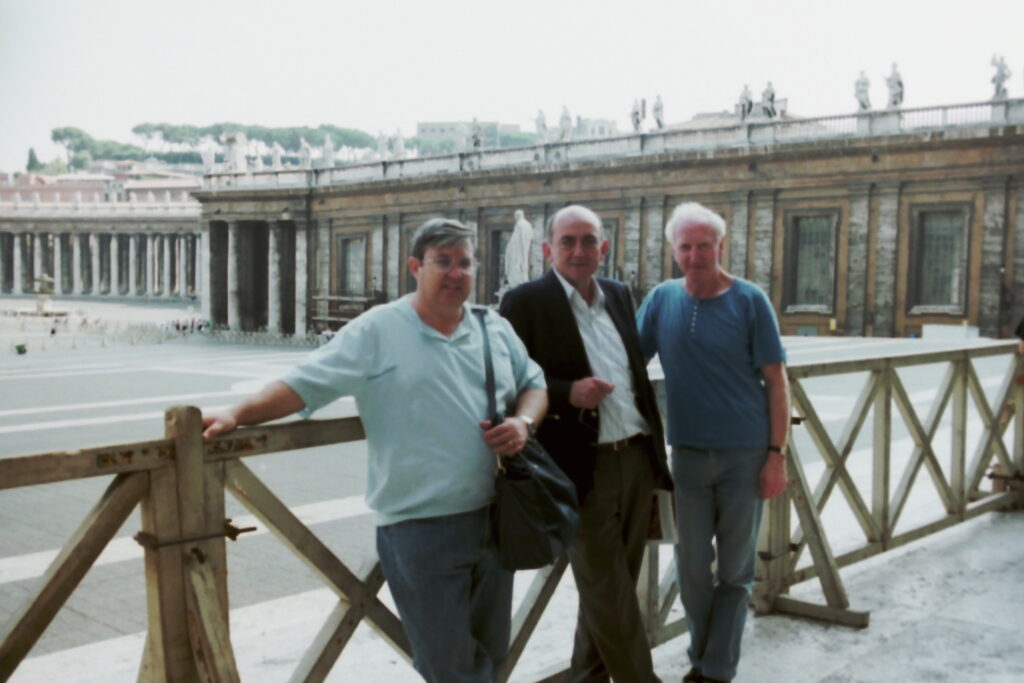
Bruce (far right) standing next to Bob Greenwood and me in Rome.
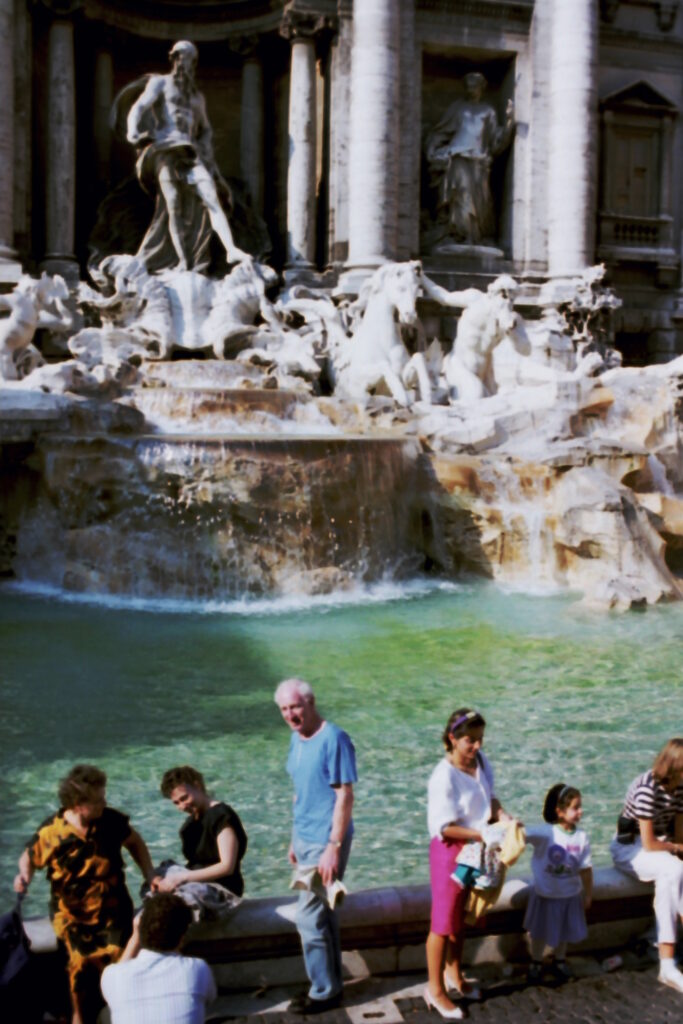
Bruce, after throwing “thee coins” in the Trevi Fountain, Rome.
I believe my second mission with Bruce, and other SIU members, was in July the following year, 1989. The team left Sydney on 13 July on our way to Minsk in Belarus, via London and Moscow, to undertake investigations in relation to several SIU persons of interest.
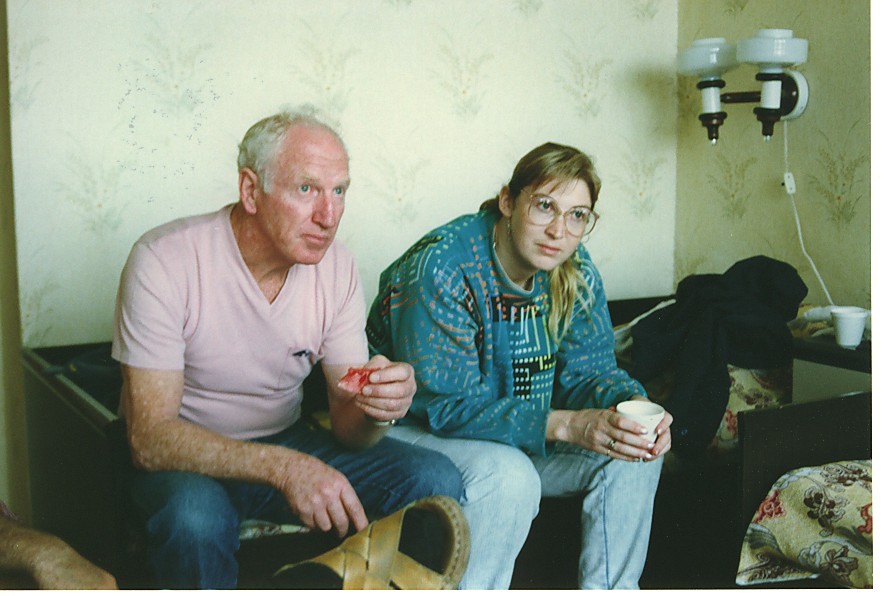
Bruce with SIU analyst Anne Brettingham Moore, at a team de-brief at our hotel in Minsk.
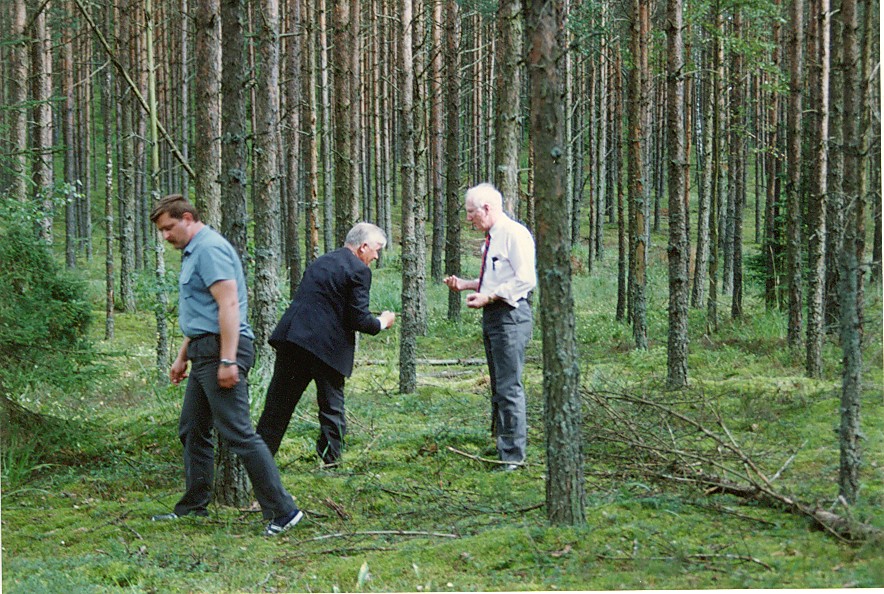
Bruce with the Chief Minsk Procurator (Prosecutor), gathering field mushrooms in a forest near Minsk.

SIU team members at the Khatyn Memorial in Minsk.
(left to right: Graham Blewitt; Belarus Procurator; Bruce Huggett; Anne Brettingham-Moore; Dick Letchford and Prof Konrad Kwiet)

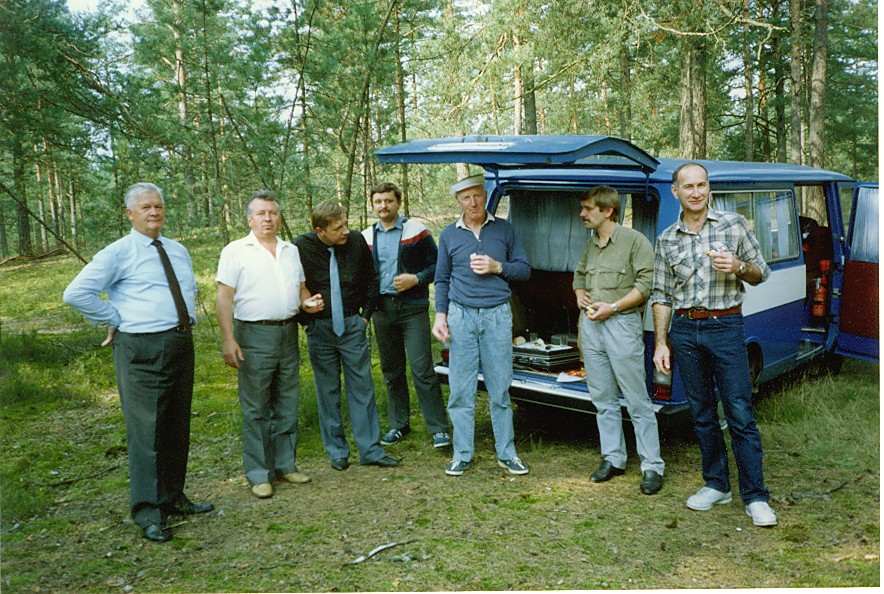
Bruce with SIU investigator Dick Letchford (far right) and members of the Soviet Procurator’s Office near Minsk.
Bruce was a quiet man and often kept to himself. He was a non-drinker and a non-smoker. He rarely forced his views about various topics onto others. To demonstrate how humble and quiet he was, in June 1989, just one month prior to this investigative mission to Belarus, he had been awarded the Order of Australia, for ‘Police Service and Public Service’ and was made a Member of that Order (AM). This was a significant award, yet he kept the fantastic news to himself.
My next mission with Bruce and other SIU team members was when we left Sydney on 28 November 1989 to carry out investigations in relation to Ivan Polyukhovich and other SIU persons of interest. Our final destination was Rovno (now Rivne) in Ukraine. It was one of the first SIU investigative missions involving the interview of witnesses in the Soviet Union. We travelled to London, then Moscow and finally to Rovno, arriving there on 2 December. Our team of five consisted of Bruce, Bob Reid (the SIU investigator in charge of the Polyukhovich case), team analyst Ann Dowd, interpreter Eugene Ulman, and me.
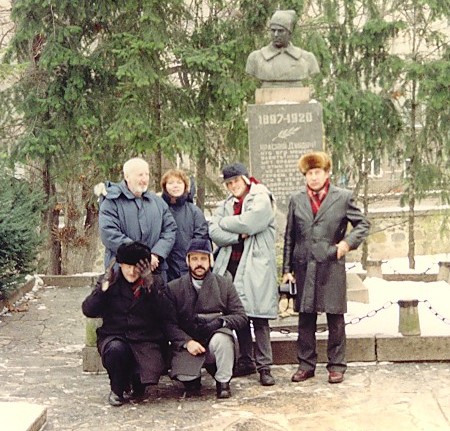
The team in Rovno. Back row (left to right) Bruce, Ann Dowd, Eugene Ulman and a local Procurator. In the front row is Stas Kostetsky our local Ukrainian interpreter on the far left, next to Bob Reid.
The team’s exploits on this mission to Rovno and Serniki will be dealt with in more detail in my forthcoming book about the work of the SIU.
I will, however, provide some small detail about our time in the Soviet Union on this mission which will not be covered in the book. We had been warned before we left Australia that we should be prepared to encounter winter temperatures of minus 40 degrees Celsius. In preparation for the mission, in light of this warning, Bob, Bruce and I grew beards to help shield ourselves against the anticipated cold. In addition we acquired warm duck-down coats from Canada and also some thermal underwear, which we picked up when transiting London. On our first day in Rovno, we were taken by foot, trudging through the snow, to the Procurators Office, which was about one kilometre from our hotel.

The Procurator’s Office was where the interviews would take place. We did not realise the building would be centrally heated, so we all wore our thermal underwear. On arrival at the office we realised we had made a mistake – we should not have worn such warm clothing, and we found the office stifling hot. To overcome this situation we quickly opened the windows to let in some cool air, much to the consternation of Madam Kolesnikova the chief war crimes procurator from Moscow, who said we would all die of pneumonia.

Ann Dowd (left window) with Bruce and Bob Reid at other open window of the Procurator’s office, letting some cooler air into the hot room.

Rovno Procurator’s office building – we were in a conference room on the top floor.

Bruce and Ann preparing for a witness interview.
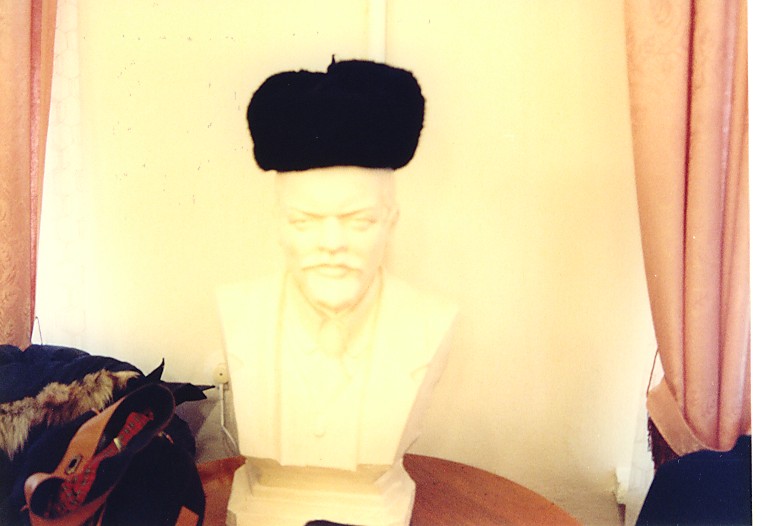
The bust of Lenin in the office provided a convenient hat stand – although no offence was intended.
Our mission to Ukraine was successful and led to criminal proceedings being commenced in January 1990 against the accused Ivan Polyukhovich. There is a separate blog on this website dealing with the mass grave exhumation undertaken in Serniki in relation to this case.
We spent almost the entire month of December in Rovno and Serniki. This meant the team members spent almost every waking moment together, either at the office, in our hotel (where we had most of our meals) or when at leisure. I think meal times were the hardest for Bruce. The Soviet Union was in decline and food was scarce. Even though we had adequate food, the choices were not great and most times we had to accept what was on offer. At the best of times, Bruce was a fussy eater. At most meals it was a real struggle for him to eat what was available. Often the way it was prepared/cooked, presented real problems for him. He liked simple foods and in his view, the only way to eat a steak was to have the “arse burnt out of it”.
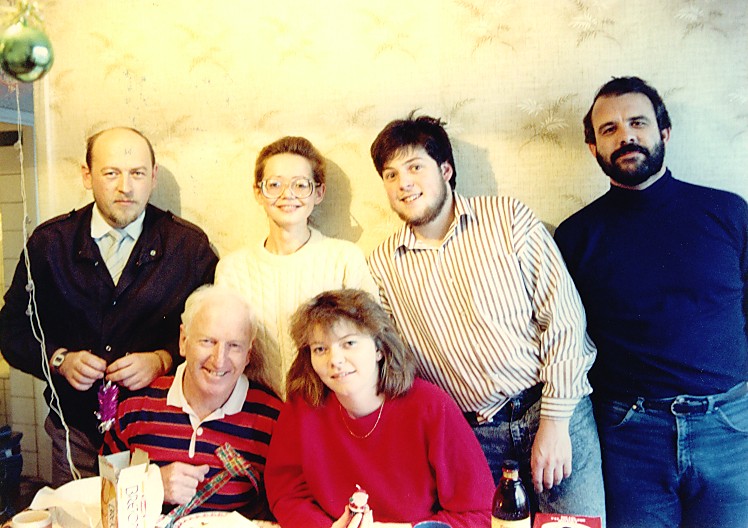
Christmas Day in Rovno – the lady in the back row between Stas and Eugene is Marina, another local Ukrainian interpreter. At this stage of the mission, Bruce and I had shaved our beards off.

Bruce with Ann and me, at a farewell conference with the local Procurators in Rovno.
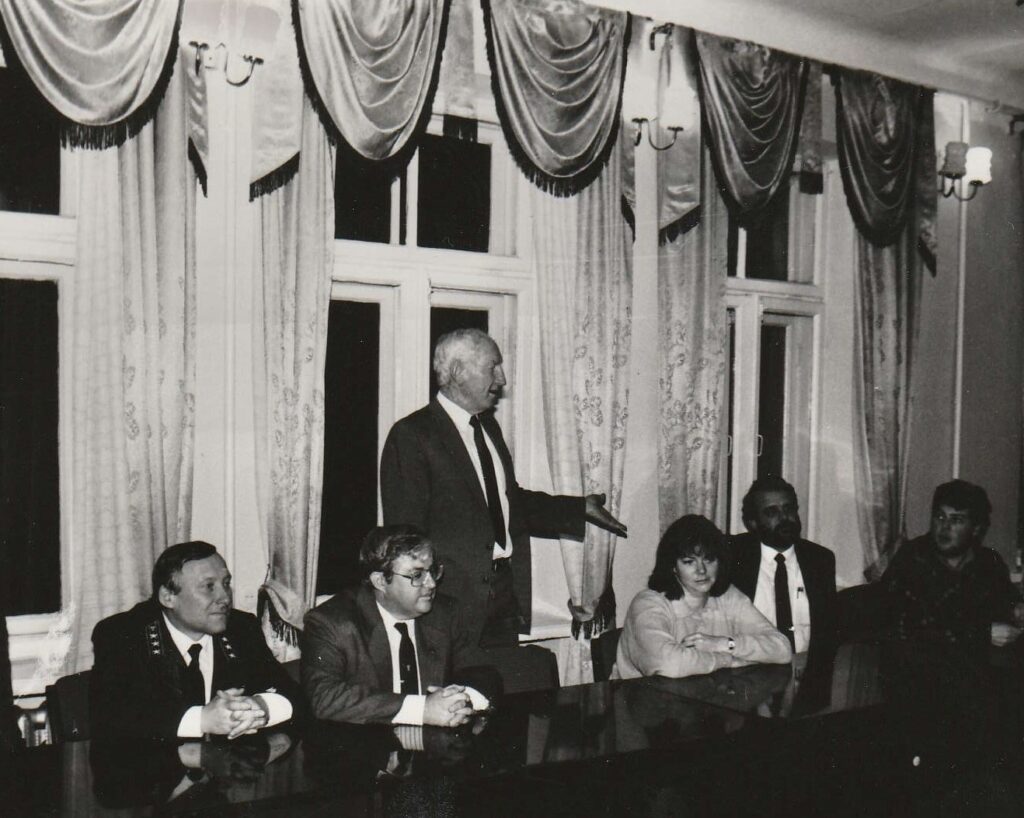
When our work was finished in Rovno, the team returned to Moscow by train, rather than risking another nervous and dangerous flight with Aeroflot. It was a relaxing journey after the hustle and bustle of the long investigative mission in Ukraine.

We departed Rovno by train on 28 December, bound for Moscow. Here Bruce is enjoying a cup of tea, with Ann sitting opposite.
Bob Reid has reflected on the role Bruce played in Bob’s very successful career pursuing war criminals. Bob recalls:
“I first met Bruce in 1979 when I was transferred from 21 Division to Eastwood Detectives as a trainee detective. Bruce was the Divisional Detective Senior Sergeant and my boss. I found him down to earth, friendly and a person with integrity. Above all though, he took an interest in all the young trainees and made sure we were being taught correctly and how to do things the right way.
.
After a short stay at Eastwood, I was transferred to Balmain and we did not have contact with each other until I met up with him again when he was the boss of the National Crime Authority in about 1985. Again, he was the same old Bruce. Straightforward and down to earth with an eagerness to teach us to be the very best we could. After a short while, Bruce was promoted and went to internal affairs as the boss. I remained at the National Crime Authority and our paths did not cross (thankfully, given the job he had taken on) until June 1987 when I was walking through Hyde Park to Police Headquarters. He was coming the other way and we stopped and talked for some time. At the end of the conversation he asked me whether I knew a Detective Sergeant I trusted. Knowing the job he was doing, I was not going to volunteer one of my colleagues and told him I couldn’t think of anyone at the moment, but I would give it some thought. When I returned to the NCA later that afternoon I relayed my conversation to one of my colleagues. He informed me that Bruce was no longer at Internal Affairs but a newly formed organisation called the Special Investigations Unit under the auspices of the Federal Attorney General’s Department. The next morning I rang Bruce and told him I still could not think of a Detective Sergeant, but I knew a great Detective Senior Constable, me. He laughed and asked could I come for an interview at their offices. When I got to the interview, Bob Greenwood, the Director was also there. I also knew him from the National Crime Authority. After about fifteen minutes of conversation, I would hardly call it an interview, I was offered a position and my career in investigating war crimes was underway.
I stayed at the Special Investigations Unit from 1987 to 1991 and was then promoted to Detective Sergeant at the Drug Enforcement Agency. Bruce and I travelled together quite a lot and he was always a good travel partner. He did have rather strange eating habits in that he had to have the arse burned out of everything, but apart from that we had a lot of fun. In 1994 I travelled to The Hague and took up a position investigating war crimes in the former Yugoslavia. I retired from that post in 2018 and returned to Australia.
I owe Bruce a lot. He was a great teacher to young up and coming Detectives. He was hard but extremely fair. I look back on my chance meeting in Hyde Park with Bruce and often wonder what my career would have looked like if we had not met on that day.”

The SIU team in Moscow, prior to our departure for London and Sydney.
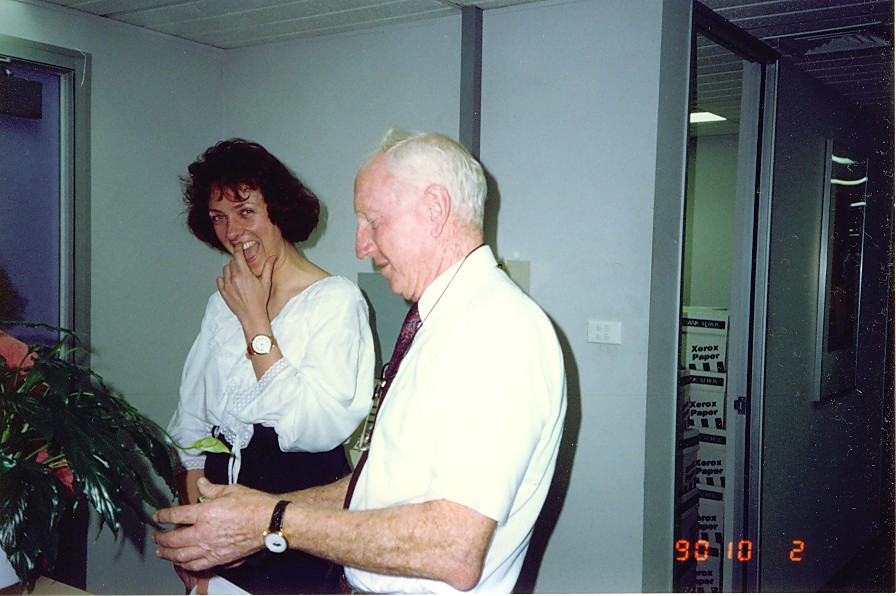
Bruce with SIU staff member Heikie Klimaschka (German Interpreter/translator) in our office in Sydney.
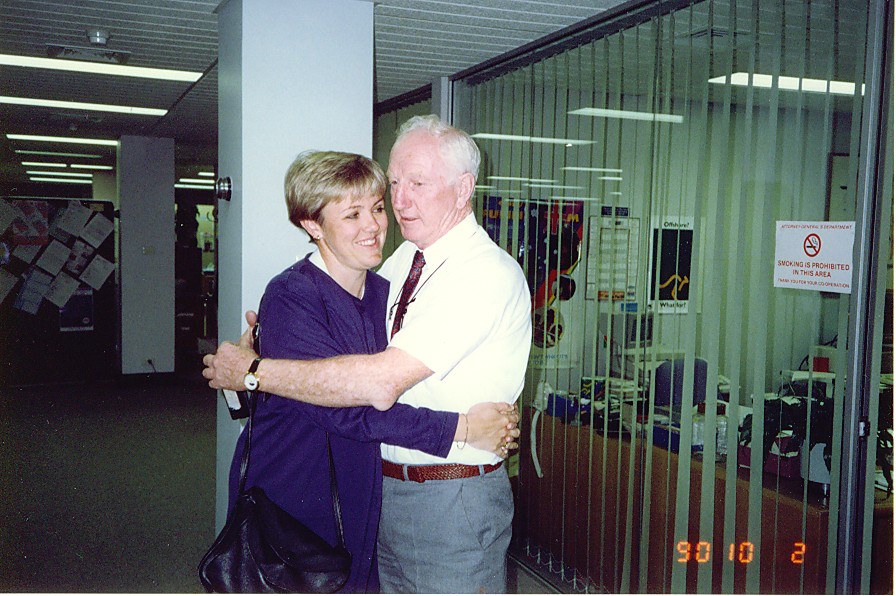
Bruce with SIU staff member Ann Fagan
Ann Fagan fondly recalls Bruce as a generous and gentle man…”I miss that man. He was one of the kindest people I’ve ever met. In 1989, I had three months off and headed to Europe on a Top Deck tour. The day before I left, Bruce handed me a signed, blank cheque just in case I needed extra money whilst overseas. I kept that cheque in my diary and on the day of his funeral (in 2008) I told his daughter Sarah the story and handed her the cheque. There are quite a few other stories of his kindness to me which I keep in my heart.”
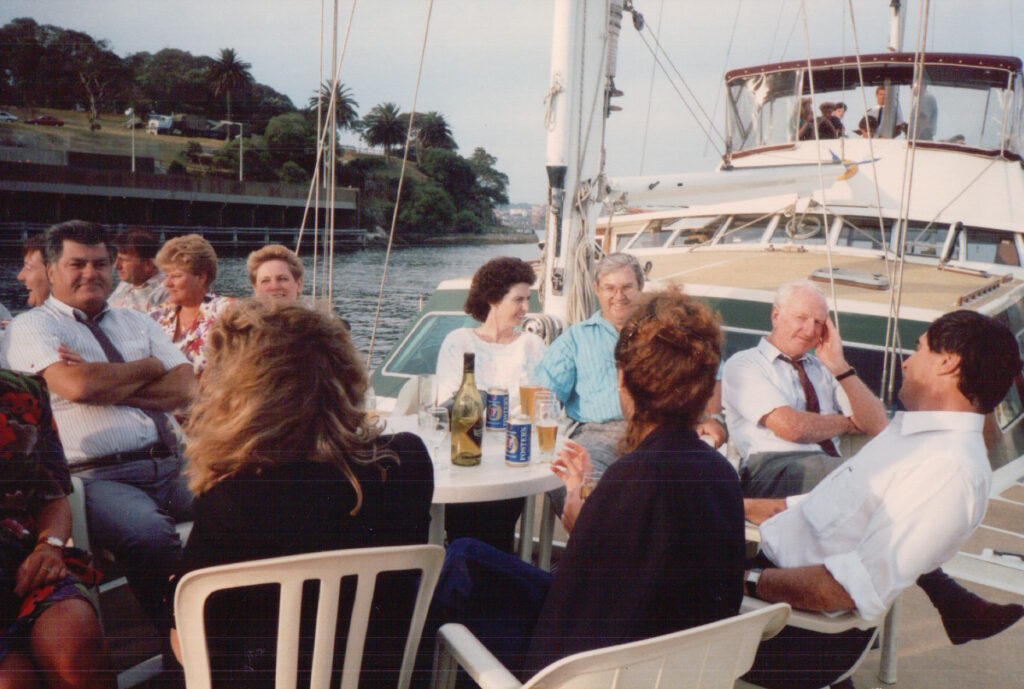
Bruce not really enjoying our 1990 end of year SIU Christmas function, on a lunch time Sydney Harbour cruise.
Bruce’s daughter, Sarah (one of Bruce’s eight children) often called into the SIU when she was studying law at Sydney University. Bruce would be very proud of his daughter who after graduating in 1991, worked in the NSW Office of the Director of Public Prosecutions for 20 years. In October 2012 Sarah was appointed a Judge of the District Court of NSW and on 12 December 2023, she was appointed a Judge of the Supreme Court of NSW. Capping off her well deserved legal career (to date), on 10 April 2024 the NSW Attorney General announced Supreme Court Justice Sarah Huggett’s appointment as the first female Chief Judge of the NSW District Court.
Regrettably Bruce died on 21 December 2008, at the age of 76, after suffering a stroke. His eight children were by his side when he passed away. His funeral took place in Sydney and was attended by well over a hundred people, including some of his former NSW Police colleagues, including the Commissioner of Police. Sarah, his daughter, said to me that her father would not have liked all the fuss. She said, in true Huggett form, “Dad would have preferred to have been thrown in the back of a ute and dumped down by the creek.” I suspect Sarah was right!
Bruce was one of a kind. He was widely recognised as one of the most accomplished police offices in the NSW Police Force. He was an outstanding leader. He was respected by members of the communities where he worked, as being an honest and fair man.
He made an important contribution to the work of the SIU and was involved in all the investigations undertaken by the Unit, including both the domestic and international investigations. He provided great assistance in arranging for the overseas witnesses, in particular the Soviet witnesses, to travel to and testify in Adelaide.
After leaving the SIU, Bruce bought a property in Rylstone in the Central West of NSW and enjoyed collecting antiques, attending clearing sales and raising a small herd of cattle.
During this time he became the Mayor of Rylstone and volunteered for the local bush fire brigade. Some years later Bruce bought a property at Bakers Swamp where he used to live. He became a Councillor in the local council in Wellington and ran a small herd of cattle and collected antiques. During this period, one of Bruce’s neighbours became paralysed and, typically, Bruce helped out by undertaking a lot of farm work for his neighbour. Being a very generous man, Bruce received awards from the Red Cross having donated blood over 100 times.
Everyone loved Bruce, he was one of a kind. He was a good friend, and a warm human being. He was intelligent, very capable, and his integrity was never questioned. We all miss him dearly.